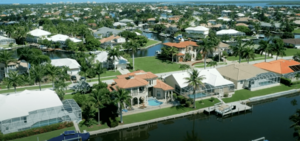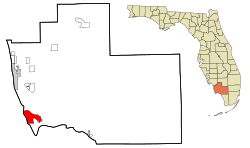Marco Island, Florida facts for kids
Quick facts for kids
Marco Island, Florida
|
|
|---|---|
| City of Marco Island | |
 |
|
| Nickname(s):
La Isla de San Marco
|
|

Location in Collier County and the state of Florida
|
|
| Country | United States |
| State | Florida |
| County | Collier |
| Area | |
| • Total | 24.66 sq mi (63.88 km2) |
| • Land | 12.16 sq mi (31.49 km2) |
| • Water | 12.51 sq mi (32.39 km2) |
| Elevation | 10 ft (3 m) |
| Population
(2020)
|
|
| • Total | 15,760 |
| • Density | 1,296.37/sq mi (500.52/km2) |
| Time zone | UTC-5 (Eastern (EST)) |
| • Summer (DST) | UTC-4 (EDT) |
| ZIP Codes |
34145–34146
|
| Area code(s) | 239 |
| FIPS code | 12-43083 |
| GNIS feature ID | 0286403 |
Marco Island is a small sea island, or barrier island, on the Gulf Coast of the United States. Located 20 miles (32 km) south of Naples in Collier County, Florida it is 198 nautical miles to Havana. It is the largest of the Ten Thousand Islands. Marco Island is an affluent beach and boating resort island with a small-town character. It is home to the JW Marriott Marco Island Beach Resort and Hilton Marco Island Resort, a golf club, a yacht club, a country club, several parks, and nature areas. The six-mile crescent beach on Marco Island is among the widest in Florida and features bright white, sugar sand, and bountiful shelling opportunities. There are two public access locations with parking and amenities (Tigertail and South Beach), a private beach complex for residents (Residents' Beach), and a private parking area for residents (Sarazen Park at South Beach), and two other public access points (with no amenities). Access to offshore island beaches, such as Keewaydin, are conveniently accessed by boat or tour. Marco is close to the shopping and restaurants of Naples.
Marco Island is a principal city of the Naples–Marco Island Metropolitan Statistical Area. The population was 15,760 at the 2020 census. The population more than doubles in size during the winter season. A daily ferry connects the island to Key West.
Marco Island is the largest barrier island within Southwest Florida's Ten Thousand Islands area extending southerly to Cape Sable. Parts of the island have some scenic, high elevations relative to the generally flat south Florida landscape. Like the city of Naples to the north, Marco Island has a tropical climate; specifically a tropical wet and dry or savanna type (Aw under the Köppen system). It is known for its distinct wet and dry seasons, with most of the rainfall falling between the months of June and October.
Contents
History
The history of Marco Island can be traced as far back as 500 A.D., when the Calusa people inhabited the island as well as the rest of southwest Florida. A number of Calusa artifacts were discovered on Marco Island in 1896 by anthropologist Frank Hamilton Cushing as part of the Pepper-Hearst Expedition. The most notable artifact discovered was the carved wooden "Key Marco Cat" which is now on display at the Smithsonian Institution.
When Spanish explorers came to the island in the mid 1500s, they gave the island the name La Isla de San Marcos after Gospel writer St. Mark.
Early development of the island began in the late 1800s after the arrival of William Thomas Collier and his family. Collier founded the village of Marco on the island in 1870, and in 1896 Collier's son, William D. "Capt. Bill" Collier, opened a hotel on the island, known today as the Olde Marco Inn.
Clam digging became a major industry on Marco Island and throughout the Ten Thousand Islands in the early 1900s. The Burnham Clam Cannery began operation near Caxambas Pass in 1903 and operated until 1929. The Doxsee Clam Cannery also operated from 1911 to 1947.
Ferry service began to the island in 1912, which operated between Marco Island and the Isles of Capri. A road on the mainland linked the ferry landing with East Naples (just west of State Road 951). A small piece of this road still exists today and is known as Barefoot Williams Road.
Barron G. Collier (whom Collier County is named after, and of no relation to William T. Collier) purchased a large amount of land on Marco Island in 1922, and in 1927 the island incorporated as Collier City. Collier City was abolished in 1957. James Harvey Doxsee Sr. served as Collier City's only mayor.
Also in 1927, the Atlantic Coast Line Railroad began service to the island after extending their route from Fort Myers and Naples. The railroad ran to the island along the present route of State Road 951. Rail service was discontinued in 1944.
The first vehicle bridge to the island was a small wooden swing bridge built in 1938 near Goodland on the southeast side of the island. Remnants of this bridge can be seen today next to the current Goodland Bridge (built in 1975). The island's ferry service was discontinued after the original Goodland Bridge opened.
Significant development of Marco Island took place in the 1960s that made it into the tourist destination it is known as today. The Mackle brothers of the Deltona Corporation led the development of the island after purchasing large amounts of land on the island for $7 million. As a result of development, the S.S. Jolley Bridge opened for traffic in 1969.
Marco Island was reincorporated as a city on August 28, 1997.
Geography
Marco Island is located in southwestern Collier County at 25°56′26″N 81°42′53″W / 25.94056°N 81.71472°W (25.940619, -81.714843), along the Gulf of Mexico.
According to the United States Census Bureau, the city has a total area of 22.8 square miles (59.0 km2), of which 12.1 square miles (31.4 km2) is land and 10.7 square miles (27.6 km2) (46.73%) is water.
Demographics
| Historical population | |||
|---|---|---|---|
| Census | Pop. | %± | |
| 1980 | 4,694 | — | |
| 1990 | 9,493 | 102.2% | |
| 2000 | 14,879 | 56.7% | |
| 2010 | 16,413 | 10.3% | |
| 2020 | 15,760 | −4.0% | |
| U.S. Decennial Census | |||
2020 census
| Race | Number | Percentage |
|---|---|---|
| White (NH) | 13,999 | 88.83% |
| Black or African American (NH) | 53 | 0.34% |
| Native American or Alaska Native (NH) | 19 | 0.12% |
| Asian (NH) | 175 | 1.11% |
| Pacific Islander (NH) | 1 | 0.01% |
| Some Other Race (NH) | 32 | 0.2% |
| Mixed/Multi-Racial (NH) | 324 | 2.06% |
| Hispanic or Latino | 1,157 | 7.34% |
| Total | 15,760 |
As of the 2020 United States census, there were 15,760 people, 8,379 households, and 5,714 families residing in the city.
2010 census
As of the census of 2010, there were 16,413 people, 7,517 households, and 17,134 housing units in the city. The population density was 1,352.0 inhabitants per square mile (543.5/km2). There were 14,826 housing units at an average density of 1,402.1 per square mile (12.14 square miles). The racial makeup of the city was 95.9% White, 0.5% African American, 0.1% American Indian, 1.1% Asian and 7.1% Hispanic or Latino.
There were 7,517 households, out of which 9.4% had children under the age of 18 living with them, 46.7% were 65 years of age or older. The average household size was 2.21.
The median income for a household in the city was $73,373, and the per capita income was $52,089. 2.1% of the population were below the poverty level.
Transportation
The Marco Island Executive Airport (MRK) provides air service to the area. It is located four miles (6.4 km) northeast of the central business district of Marco Island.
Marco Island is served by Collier Area Transit's Route #21 and Route #121 (Express: Immokalee to Marco Island)
Education
The District School Board of Collier County operates the following schools serving Marco Island:
- Marco Island Academy High School
- Marco Island Charter Middle School
- Tommie Barfield Elementary School
Private schools:
- Island Montessori Academy
- Marketplace Mission Learning Center
Notable people
- John Boehner
- Michael Collins, astronaut
- William J. Cullerton, World War II flying ace
- Leighton Meester
See also
 In Spanish: Marco Island para niños
In Spanish: Marco Island para niños

